Learning about the Retail Industry
- The American retail industry has been growing significantly;
- The market has not reached saturation yet;
- Current annual revenue of the market: $3.53 trillion;
- Essential characteristics: high levels of competition.
The analysis of the American retail industry has shown that the levels of competition in it are quite strong, which makes companies build a strong competitive advantage to survive. With low bargaining power of buyers and suppliers, as well as high threats of new entrants, the industry has been growing, and the market has been maturing fast (Hortaçsu & Syverson, 2015). According to the 2018 report, the American retail market has reached the annual revenue of $3.53 trillion (Anders, 2018). Therefore, it is critical for companies operating in the retail sector to build a competitive advantage for these organizations to attract new customers.
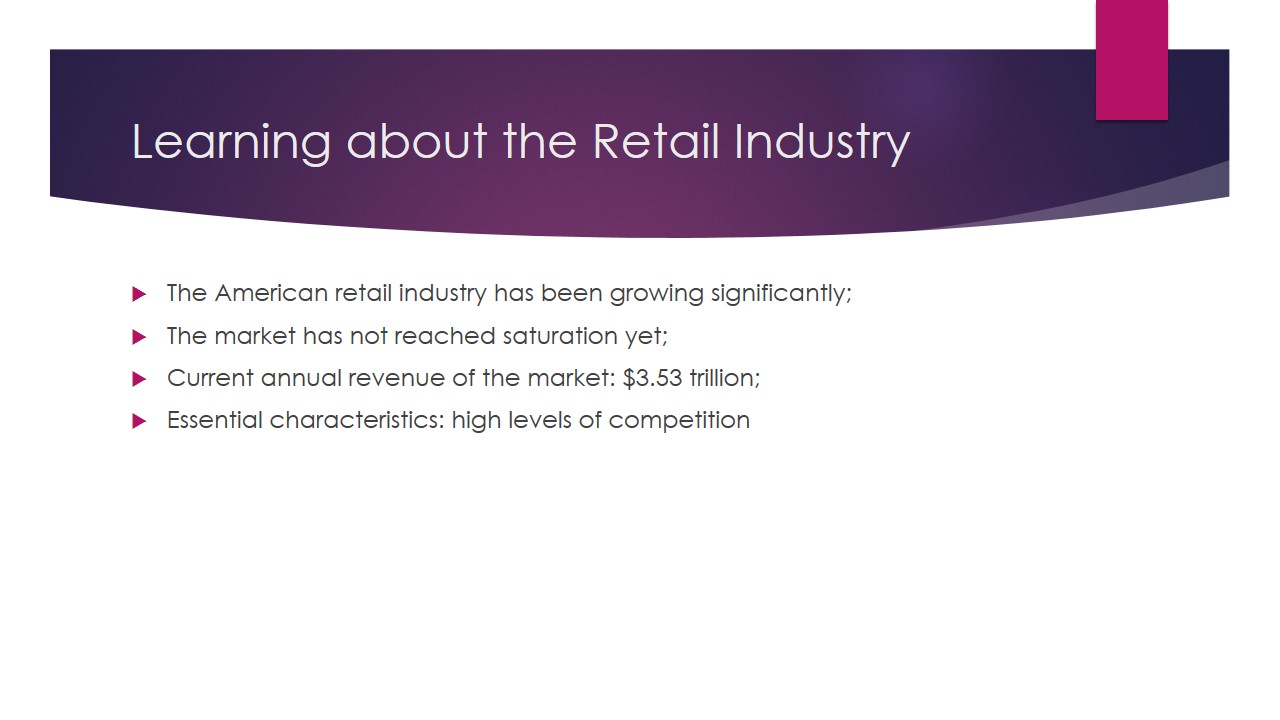
Learning about the Organization
- Walmart’s key competitive advantage: the lowest price for the medium quality;
- Current position: strong, with extensive support;
- Key needs: increasing diversity in the workplace;
- Possible future opportunities: expansion in other markets.
Walmart takes a unique position in the modern American retail market as the firm that has established the balance of the highest possible quality for the lowest possible price. With the reputation of the best known retailer in the industry, Walmart has gained the support of a large audience that is growing exponentially (Pope & Pope, 2015). The assessment has shown that Walmart has cemented its status of a leader in retail, with most of its actions aimed at optimizing the production processes and minimizing costs (Richard, Su, Peng, & Miller, 2015). However, some of the organizational issues at Walmart could use certain improvements.

Assessment Outcomes and Decision-Making
- Walmart currently deploys an effective framework for decision-making;
- However, the lack of concern for diversity of employees makes the strategy weaker;
- A new approach toward managing cultural differences in the workplace is needed.
The outcomes of the analysis indicate that Walmart needs to strengthen its organizational framework and address some of the cultural aspects of its functioning. For example, a stronger emphasis should be placed on diversifying the workplace and promoting equity among staff members. Simultaneously, Walmart should ensure that ethical standards remain uniform across its departments as the company expands. The firm should take the needs of its employees seriously and adopt a culturally sensitive strategy to adjust to the requirements of its staff members. Thus, future progress can be expected.
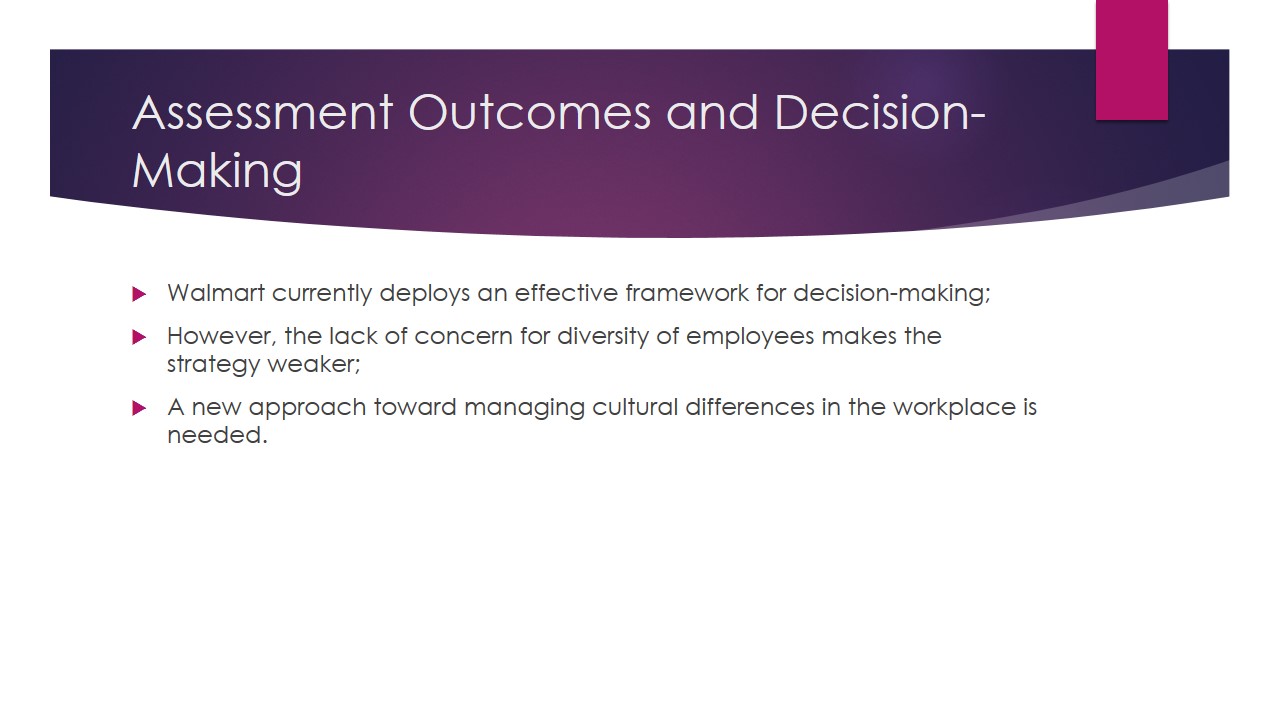
Key Insights, Lessons Learned, and the Original Vision
- High levels of rivalry within the market;
- Need to promote corporate loyalty among staff members;
- Key strengths: effective marketing, good management, sufficient finances;
- Key weaknesses: lack of a diversity-focused HRM approach;
- Opportunities: enhanced R&D, entrance to a new market, e3nhancement of information systems;
- Threats: failure to meet diverse employees’ needs; lack of a risk management framework.
The lessons that the story of Walmart gives concerns the necessity to incorporate all aspects of a company’s functioning into the analysis when defining the path for the future development. Despite being a doubtless champion in the American retail sector, Walmart currently risks losing its position due to a drop in the staff’s loyalty levels. Therefore, considering a culturally sensitive approach toward HRM should be seen as a necessity in the described scenario. The organization should integrate a system of values aimed at meeting the needs of employees among other stakeholders and creating a positive workplace environment.
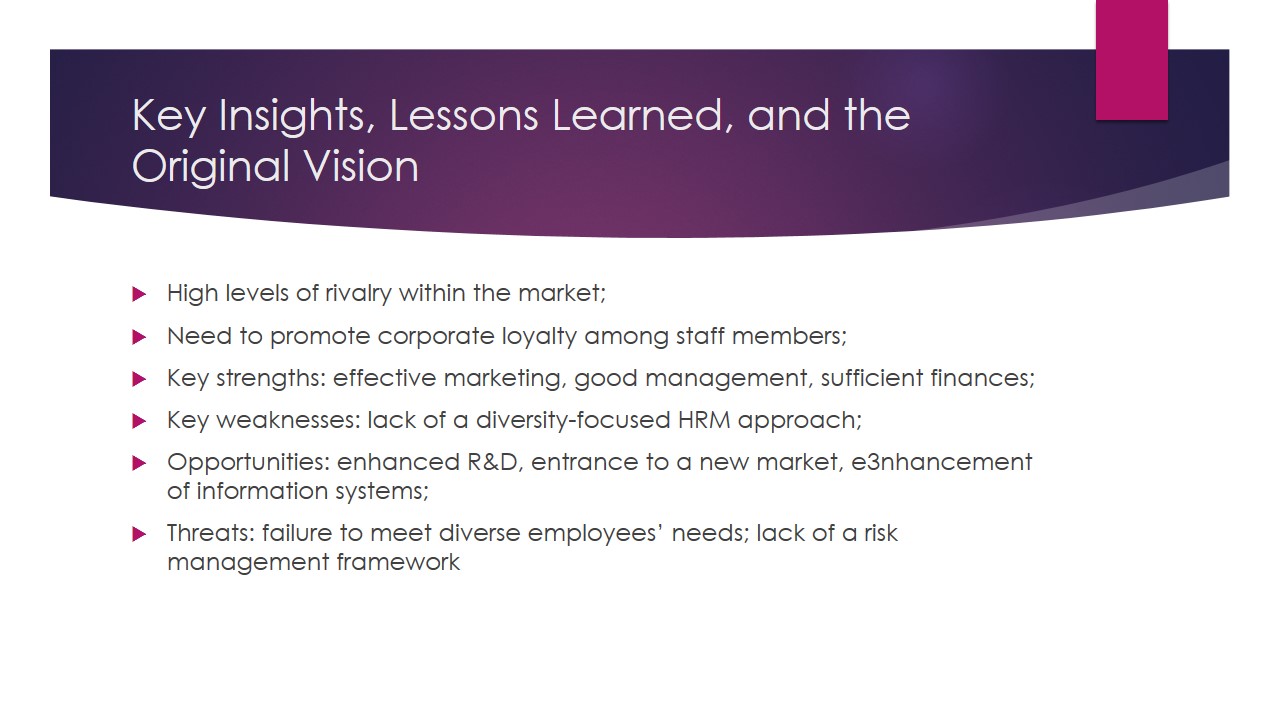
Preliminary Strategic Initiative Plan
- Changing the corporate values toward an employee-oriented strategy;
- Focusing on meeting the needs of all parties involved;
- Promoting ethical decision-making;
- Building an HRM-based competitive advantage.
The current strategic initiative involves mostly addressing the lack of focus on diversity in the workplace. Introducing strategies for meeting the needs of employees from all cultural backgrounds is critical for the stellar performance of the organization.
In order to enhance the current competitive advantage of the firm, Walmart will need to improve its workplace environment significantly. Thus, a new model of leadership that encompasses transformation and the focus on ethical decision-making should be introduced.
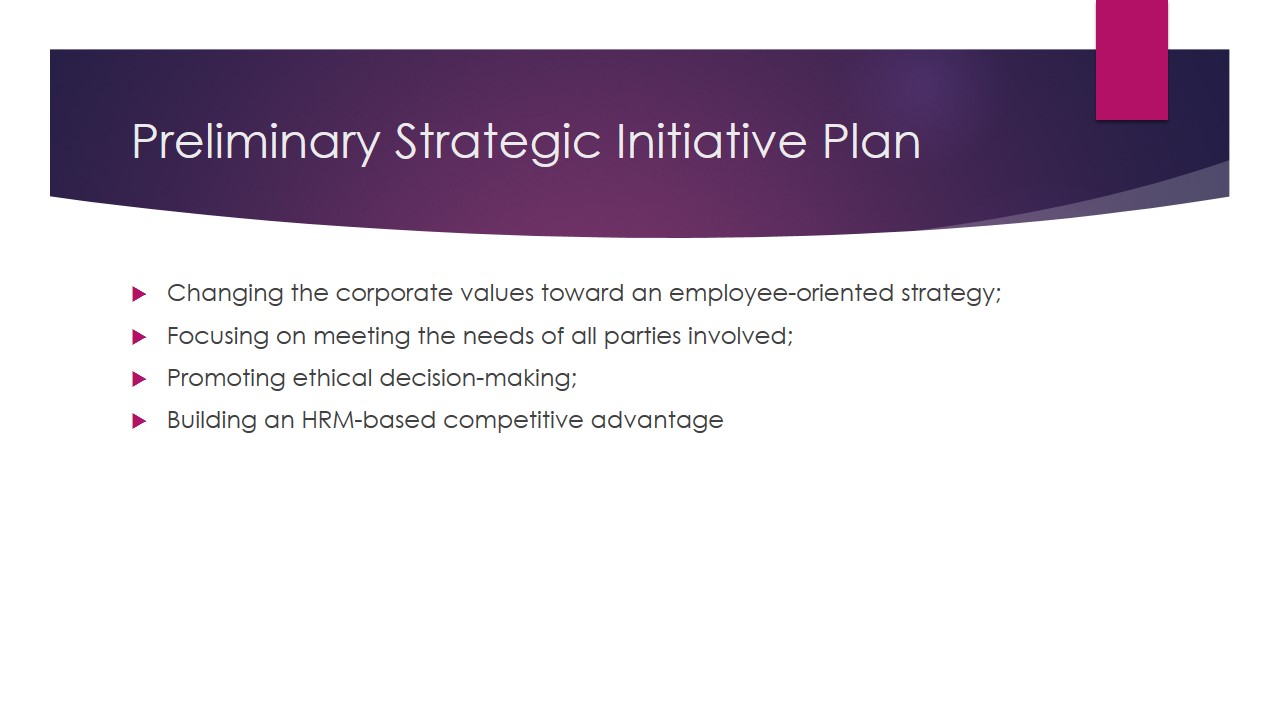
Considering Cultural Aspects of the Plan
- Cultural elements of the plan: the bulk of the program;
- Introducing culture-oriented corporate policies to increase the firm’s performance effectiveness;
- Offering additional workplace benefits to staff members;
- Making the organizational environment flexible to meet the staff’s needs.
At present, the significance of the cultural aspects of the proposed plan is very high. Since Walmart’s appeal to customers is quite high, focusing on the low levels of loyalty toward the company among staff members needs to become the firm’s priority. For this reason, the action plan should incorporate the elements that will enhance the organizational development of the firm. Specifically, the plan will need to focus on providing staff members with additional workplace benefits implying that their culture and ethnic background is recognized. Similarly, the communication strategy used at Walmart will have to be shaped to address the unique characteristics of employees.
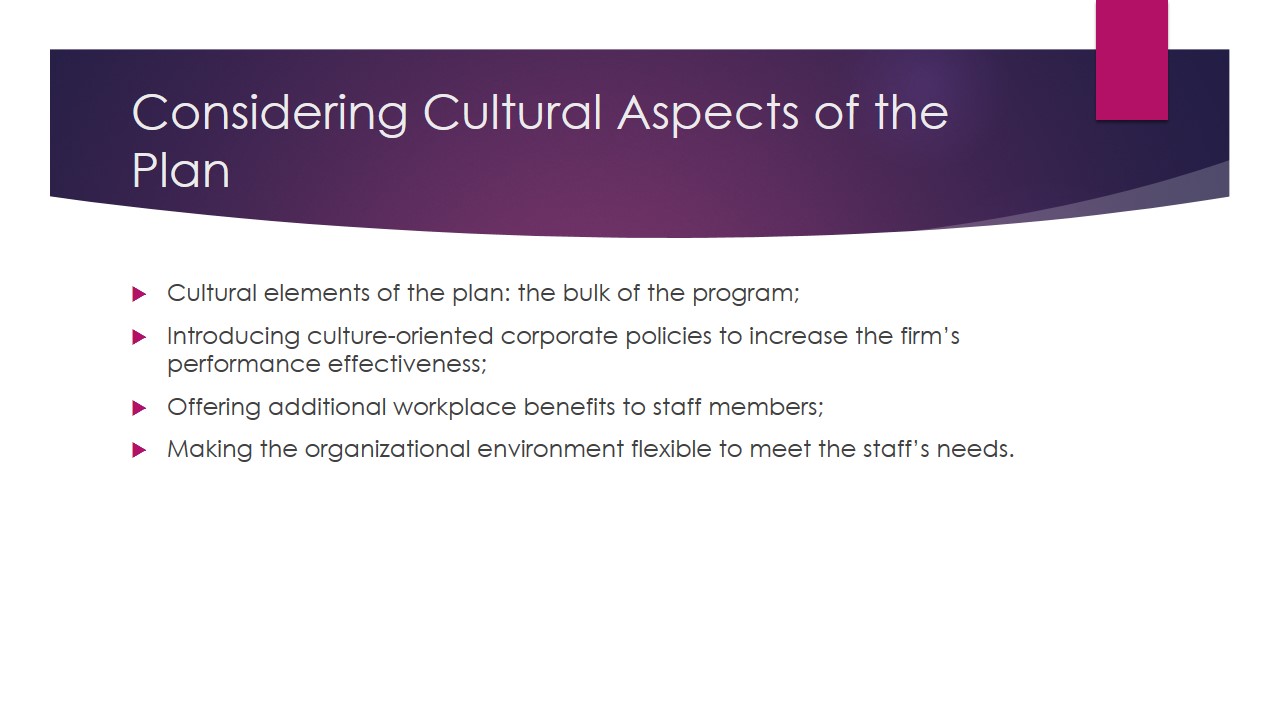
Conclusion
- Walmart: current leader in the American retail market;
- Further goals: expanding into the global economic setting;
- Threats: increasingly high rates of rivalry;
- High probability of being ousted from the market by new entrants;
- Need to shape the current approach toward managing employees’ needs;
- A more diversity-oriented attitude as the focus of the future changes.
Creating the setting in which every staff member feels appreciated and recognized is one of the requirements for the company to thrive in the selected market. Walmart has been at the helm of the global retail industry for a while due to the incredibly low prices for moderately good products, yet its current approach could use some revisiting in regard to the company’s cultural principles. Acknowledging and celebrating diversity in the workplace is currently one of the key concerns for Walmart since new and more progressive rivals may oust the company from the global market with the help of a more attractive framework for HRM and employee relationships.

Appendix A: Porters’ 5 Forces Analysis
As the figure provided above shows, Walmart has been performing exceptionally well in the global retail market over the past decade due to the strong competitive advantage that the firm has developed over the years. However, the specified approach seems to have lost its novelty for the organization, with new problems emerging from within. Specifically, Walmart will need to pay closer attention to the issue of the lack of diversity-based approach in its current HRM policy. The absence of concern for culture-specific needs of its staff may cause Walmart to lose its influence in the target economic setting and raise the existing loyalty rates among staff members. Thus, Walmart will increase the pace of its steady progress, aiming at a large audience and improving the quality of its employees’ work.

References
Anders, M. (2018). Retail industry expects more sales growth in 2018. Forbes. Web.
Hortaçsu, A., & Syverson, C. (2015). The ongoing evolution of US retail: A format tug-of-war. Journal of Economic Perspectives, 29(4), 89-112.
Pope, D. G., & Pope, J. C. (2015). When Walmart comes to town: Always low housing prices? Always? Journal of Urban Economics, 87, 1-13.
Richard, O. C., Su, W., Peng, M. W., & Miller, C. D. (2015). Do external diversity practices boost focal firm performance? The case of supplier diversity. The International Journal of Human Resource Management, 26(17), 2227-2247.